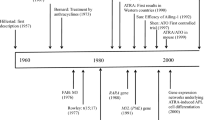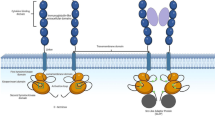Abstract
The classical treatment scheme for medulloblastoma (MB) is based on a tri-therapy approach consisting of surgical tumor resection, craniospinal axis radiation and chemotherapy. With current treatments relying mainly on non-specific cytotoxic therapy, a better understanding of the mechanisms underlying resistance to these treatments is important in order to improve their effectiveness. In this study, we report that stimulation of DAOY with HGF resulted in the protection of these cells against etoposide-induced apoptosis, this anti-apoptotic effect being correlated with an increase in the expression of tissue factor (TF), the initiator of the extrinsic pathway of coagulation. HGF-mediated protection from apoptosis was abolished by a c-Met inhibitor as well as by siRNA-mediated reduction of TF levels, implying a central role of Met-dependent induction of TF expression in this process. Accordingly, stimulation of DAOY with FVIIa, the physiological ligand of TF, also resulted in a significant protection from etoposide-mediated cytotoxicity. Overall, our results suggest the participation of the haemostatic system to drug resistance in MB and may thus provide novel therapeutic approaches for the treatment of these tumors.




Similar content being viewed by others
Abbreviations
- MB:
-
Medulloblastoma
- TF:
-
Tissue factor
- RTK:
-
Receptor tyrosine kinase
- HGF:
-
Hepatocyte growth factor
References
Crawford JR, MacDonald TJ, Packer RJ (2007) Medulloblastoma in childhood: new biological advances. Lancet Neurol 6:1073–1085
Rossi A, Caracciolo V, Russo G, Reiss K, Giordano A (2008) Medulloblastoma: from molecular pathology to therapy. Clin Cancer Res 14:971–976
Grotzer MA, Janss AJ, Phillips PC, Trojanowski JQ (2000) Neurotrophin receptor TrkC predicts good clinical outcome in medulloblastoma and other primitive neuroectodermal brain tumors. Klin Padiatr 212:196–199
Duplan SM, Theoret Y, Kenigsberg RL (2002) Antitumor activity of fibroblast growth factors (FGFs) for medulloblastoma may correlate with FGF receptor expression and tumor variant. Clin Cancer Res 8:246–257
Gilbertson RJ, Clifford SC, MacMeekin W, Meekin W, Wright C, Perry RH, Kelly P, Pearson AD, Lunec J (1998) Expression of the ErbB-neuregulin signaling network during human cerebellar development: implications for the biology of medulloblastoma. Cancer Res 58:3932–3941
MacDonald TJ, Brown KM, LaFleur B, Peterson K, Lawlor C, Chen Y, Packer RJ, Cogen P, Stephan DA (2001) Expression profiling of medulloblastoma: PDGFRA and the RAS/MAPK pathway as therapeutic targets for metastatic disease. Nat Genet 29:143–152
Gilbertson RJ, Clifford SC (2003) PDGFRB is overexpressed in metastatic medulloblastoma. Nat Genet 35:197–198
Hartmann W, Koch A, Brune H, Waha A, Schuller U, Dani I, Denkhaus D, Langmann W, Bode U, Wiestler OD, Schilling K, Pietsch T (2005) Insulin-like growth factor II is involved in the proliferation control of medulloblastoma and its cerebellar precursor cells. Am J Pathol 166:1153–1162
Birchmeier C, Birchmeier W, Gherardi E, Vande Woude GF (2003) Met, metastasis, motility and more. Nat Rev Mol Cell Biol 4:915–925
Goumnerova LC (1996) Growth factor receptors and medulloblastoma. J Neurooncol 29:85–89
Li Y, Lal B, Kwon S, Fan X, Saldanha U, Reznik TE, Kuchner EB, Eberhart C, Laterra J, Abounader R (2005) The scatter factor/hepatocyte growth factor: c-met pathway in human embryonal central nervous system tumor malignancy. Cancer Res 65:9355–9362
Li Y, Guessous F, Johnson EB, Eberhart CG, Li XN, Shu Q, Fan S, Lal B, Laterra J, Schiff D, Abounader R (2008) Functional and molecular interactions between the HGF/c-Met pathway and c-Myc in large-cell medulloblastoma. Lab Invest 88:98–111
Benvenuti S, Comoglio PM (2007) The MET receptor tyrosine kinase in invasion and metastasis. J Cell Physiol 213:316–325
Wang X, Le P, Liang C, Chan J, Kiewlich D, Miller T, Harris D, Sun L, Rice A, Vasile S, Blake RA, Howlett AR, Patel N, McMahon G, Lipson KE (2003) Potent and selective inhibitors of the Met [hepatocyte growth factor/scatter factor (HGF/SF) receptor] tyrosine kinase block HGF/SF-induced tumor cell growth and invasion. Mol Cancer Ther 2:1085–1092
Abounader R, Laterra J (2005) Scatter factor/hepatocyte growth factor in brain tumor growth and angiogenesis. Neuro Oncol 7:436–451
Bowers DC, Fan S, Walter KA, Abounader R, Williams JA, Rosen EM, Laterra J (2000) Scatter factor/hepatocyte growth factor protects against cytotoxic death in human glioblastoma via phosphatidylinositol 3-kinase- and AKT-dependent pathways. Cancer Res 60:4277–4283
Boccaccio C, Sabatino G, Medico E, Girolami F, Follenzi A, Reato G, Sottile A, Naldini L, Comoglio PM (2005) The MET oncogene drives a genetic programme linking cancer to haemostasis. Nature 434:396–400
Provençal M, Labbé D, Veitch R, Boivin D, Rivard GE, Sartelet H, Robitaille Y, Gingras D, Béliveau R (2009) C-Met activation in medulloblastoma induces tissue factor expression and activity: effects on cell migration. Carcinogenesis 30(7):1089–1096
Price GC, Thompson SA, Kam PC (2004) Tissue factor and tissue factor pathway inhibitor. Anaesthesia 59:483–492
Ott I, Weigand B, Michl R, Seitz I, Sabbari-Erfani N, Neumann FJ, Schomig A (2005) Tissue factor cytoplasmic domain stimulates migration by activation of the GTPase Rac1 and the mitogen-activated protein kinase p38. Circulation 111:349–355
Belting M, Dorrell MI, Sandgren S, Aguilar E, Ahamed J, Dorfleutner A, Carmeliet P, Mueller BM, Friedlander M, Ruf W (2004) Regulation of angiogenesis by tissue factor cytoplasmic domain signaling. Nat Med 10:502–509
Versteeg HH, Spek CA, Richel DJ, Peppelenbosch MP (2004) Coagulation factors VIIa and Xa inhibit apoptosis and anoikis. Oncogene 23:410–417
Holen T, Amarzguioui M, Wiiger MT, Babaie E, Prydz H (2002) Positional effects of short interfering RNAs targeting the human coagulation trigger Tissue Factor. Nucleic Acids Res 30:1757–1766
Jiang X, Guo YL, Bromberg ME (2006) Formation of tissue factor-factor VIIa-factor Xa complex prevents apoptosis in human breast cancer cells. Thromb Haemost 96:196–201
Fang J, Gu L, Zhu N, Tang H, Alvarado CS, Zhou M (2008) Tissue factor/FVIIa activates Bcl-2 and prevents doxorubicin-induced apoptosis in neuroblastoma cells. BMC Cancer 8:69
Fan S, Wang JA, Yuan RQ, Rockwell S, Andres J, Zlatapolskiy A, Goldberg ID, Rosen EM (1998) Scatter factor protects epithelial and carcinoma cells against apoptosis induced by DNA-damaging agents. Oncogene 17:131–141
Guan M, Jin J, Su B, Liu WW, Lu Y (2002) Tissue factor expression and angiogenesis in human glioma. Clin Biochem 35:321–325
Hamada K, Kuratsu J, Saitoh Y, Takeshima H, Nishi T, Ushio Y (1996) Expression of tissue factor in glioma. Noshuyo Byori 13:115–118
Ueno T, Toi M, Koike M, Nakamura S, Tominaga T (2000) Tissue factor expression in breast cancer tissues: its correlation with prognosis and plasma concentration. Br J Cancer 83:164–170
Goldin-Lang P, Tran QV, Fichtner I, Eisenreich A, Antoniak S, Schulze K, Coupland SE, Poller W, Schultheiss HP, Rauch U (2008) Tissue factor expression pattern in human non-small cell lung cancer tissues indicate increased blood thrombogenicity and tumor metastasis. Oncol Rep 20:123–128
Bromberg ME, Sundaram R, Homer RJ, Garen A, Konigsberg WH (1999) Role of tissue factor in metastasis: functions of the cytoplasmic and extracellular domains of the molecule. Thromb Haemost 82:88–92
Osterholm C, Li S, Ekberg H, Hedner U, Holgersson J (2008) Downregulation of tissue factor (TF) by RNA interference induces apoptosis and impairs cell survival of primary endothelium and tumor cells. Cell Tissue Res 334(1):93–102
Rao LV (1992) Tissue factor as a tumor procoagulant. Cancer Metastasis Rev 11:249–266
Rao LV, Pendurthi UR (2005) Tissue factor-factor VIIa signaling. Arterioscler Thromb Vasc Biol 25:47–56
Koizume S, Jin MS, Miyagi E, Hirahara F, Nakamura Y, Piao JH, Asai A, Yoshida A, Tsuchiya E, Ruf W, Miyagi Y (2006) Activation of cancer cell migration and invasion by ectopic synthesis of coagulation factor VII. Cancer Res 66:9453–9460
Ruf W (2001) Molecular regulation of blood clotting in tumor biology. Haemostasis 31(Suppl 1):5–7
Luo W, Wang Y, Reiser G (2007) Protease-activated receptors in the brain: receptor expression, activation, and functions in neurodegeneration and neuroprotection. Brain Res Rev 56:331–345
Shieh SY, Ikeda M, Taya Y, Prives C (1997) DNA damage-induced phosphorylation of p53 alleviates inhibition by MDM2. Cell 91:325–334
Castellino RC, De Bortoli M, Lu X, Moon SH, Nguyen TA, Shepard MA, Rao PH, Donehower LA, Kim JY (2008) Medulloblastomas overexpress the p53-inactivating oncogene WIP1/PPM1D. J Neurooncol 86:245–256
Li C, Colman LM, Collier ME, Dyer CE, Greenman J, Ettelaie C (2006) Tumour-expressed tissue factor inhibits cellular cytotoxicity. Cancer Immunol Immunother 55:1301–1308
Sakata T, Kario K, Matsuo T, Katayama Y, Matsuyama T, Kato H, Miyata T (1995) Suppression of plasma-activated factor VII levels by warfarin therapy. Arterioscler Thromb Vasc Biol 15:241–246
Falanga A, Levine MN, Consonni R, Gritti G, Delaini F, Oldani E, Julian JA, Barbui T (1998) The effect of very-low-dose warfarin on markers of hypercoagulation in metastatic breast cancer: results from a randomized trial. Thromb Haemost 79:23–27
Ornstein DL, Meehan KR, Zacharski LR (2002) The coagulation system as a target for the treatment of human gliomas. Semin Thromb Hemost 28:19–28
Acknowledgements
We thank the Natural Sciences and Engineering Research Council of Canada (NSERC) and the Chair Claude-Bertrand in Neurosurgery for support of this work. Scholarship funding to Mathieu Provençal was provided by the MCETC/FRSQ/CIHR Strategic Training program in cancer Experimental Therapeutic. This work was supported by grants from the Natural Sciences and Engineering Research Council of Canada (NSERC).
Author information
Authors and Affiliations
Corresponding author
Rights and permissions
About this article
Cite this article
Provençal, M., Berger-Thibault, N., Labbé, D. et al. Tissue factor mediates the HGF/Met-induced anti-apoptotic pathway in DAOY medulloblastoma cells. J Neurooncol 97, 365–372 (2010). https://doi.org/10.1007/s11060-009-0041-z
Received:
Accepted:
Published:
Issue Date:
DOI: https://doi.org/10.1007/s11060-009-0041-z




